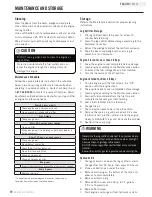
17
REV 100133-20141031
ENGLISH
100133
OPERATION
Back injury can result from lifting logs onto the log splitter
if proper lifting techniques are not used .
CAUTION
It is normal for the hydraulic fluid to become foamy or
frothy during operation .
NOTE
Log Splitter Operation
1 . ALWAYS wear ear and eye protection, protective
clothing and safety gear .
2 . Block tires and ensure support leg is secure to
prevent unintended movement of the log splitter
during operation .
3 . Load a log onto the beam against the thrust plate .
Do not hold auto control valve in return position . It
will damage the stop block or beam .
CAUTION
The cylinder stroke is designed so the wedge stops
approximately 1 .5 in . (3 .8 cm) from the end plate .
NOTE
4 . Make sure all limbs are clear of crush zones .
5 . Push and hold the control valve handle forward
(towards the wedge) to split the log . The thrust plate
will stop when the control valve handle is released, or
when the cylinder reaches the end of stroke .
6 . Push the control valve handle backward and release
to return the wedge to its original position . The
control valve handle will return to the neutral position
when the wedge is fully retracted .
7 . Clear the split wood from the work zone . If log
becomes stuck in the wedge; retract the thrust plate,
load another piece of wood and extend thrust plate to
push the stuck piece through the wedge .
Operation at High Altitude
The density of air at high altitude is lower than at sea
level . Engine power is reduced as the air mass and
air-fuel ratio decrease . Engine power and output will
be reduced approximately 3½% for every 1000 feet of
elevation above sea level . This is a natural trend and
cannot be changed by adjusting the engine . At high
altitudes increased exhaust emissions can also result
due to the increased enrichment of the air fuel ratio .
Other high altitude issues can include hard starting,
increased fuel consumption and spark plug fouling .
To alleviate high altitude issues other than the natural
power loss, Champion Power Equipment can provide a
high altitude carburetor main jet . The alternative main
jet and installation instructions can be obtained by
contacting Customer Support . Installation instructions
are also available in the Technical Bulletin area of the
Champion Power Equipment internet site .
The part number and recommended minimum altitude
for the application of the high altitude carburetor main
jet is listed in the table below .
In order to select the correct high altitude main jet
it is necessary to identify the carburetor model . For
this purpose, a code is stamped on the side of the
carburetor . Select the correct main jet part number
corresponding to the carburetor code found on your
particular carburetor .
Operation using the alternative main jet at
elevations lower than the recommended minimum
altitude can damage the engine . For operation at
lower elevations, the standard main jet must be
used . Operating the engine with the wrong engine
configuration at a given altitude may increase
its emissions and decrease fuel efficiency and
performance .
WARNING
DO NOT attempt to unstick wood by hand . NEVER
stick hands inbetween ram and wedge, when ram is
active and engine is running .
WARNING
Carburetor
Code
Main Jet
Part Number
Altitude
P19-1-Z
Standard
26 .131017 .00 .Z
3500 Feet
(1067 Meters)
Altitude
26 .131017 .00 .01 .Z
P19-1-H
Standard
26 .131017 .00 .H
Altitude
26 .131017 .00 .01 .H

































